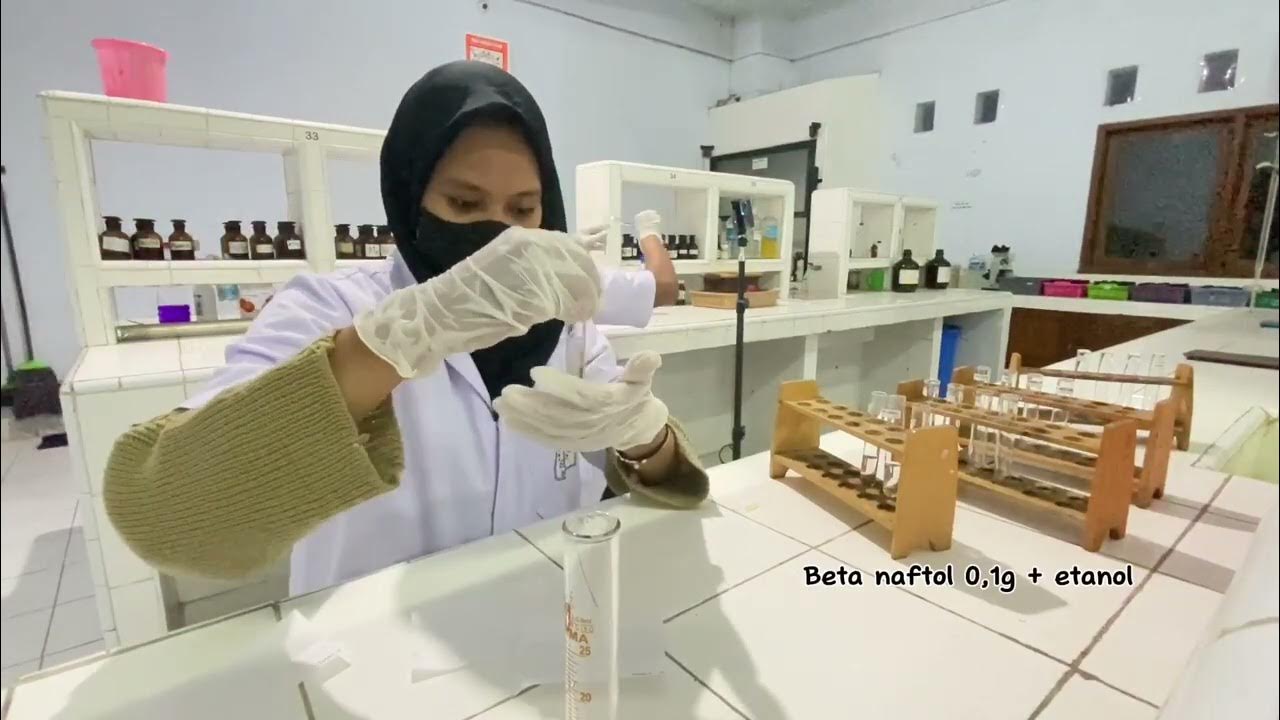Analisis Kualitatif Gugus Fungsi
Summary
TLDRIn this video, the presenter explains the process of qualitative functional group analysis of pharmaceutical compounds, using Paracetamol (acetaminophen) as a case study. Key steps include identifying the compound’s structure, selecting the appropriate reagents for functional group testing, and understanding how solvents like water or ethanol aid in the analysis. The video demonstrates how to identify functional groups like phenols and amides using specific reactions, such as the FeCl3 test for phenol identification. The tutorial emphasizes the importance of this initial analysis for further qualitative determination in pharmaceutical research.
Takeaways
- 😀 Understanding the qualitative analysis of functional groups in pharmaceutical compounds is crucial for identifying chemical structures.
- 😀 The first step in the analysis is to draw the complete structure of the compound you are studying.
- 😀 After drawing the structure, identify the functional groups present, such as amide, phenol, or ketone groups.
- 😀 Selecting the right reagents is essential for effective analysis; for example, using FeCl3 to test for phenol groups.
- 😀 Solubility plays a key role in the analysis, as the compound must dissolve in a suitable solvent to react properly with reagents.
- 😀 Paracetamol (acetaminophen) is used as an example, showcasing the process of functional group identification through its structure.
- 😀 Paracetamol contains a phenol group attached to a benzene ring and an amide group, which can be identified through specific reactions.
- 😀 The reagent FeCl3 reacts with phenol groups to produce a color change, indicating the presence of the functional group.
- 😀 When performing the test, the compound must be dissolved in a solvent like water or ethanol to ensure accurate results.
- 😀 The color changes after adding reagents (e.g., blue, purple, green, or red-brown) help confirm the presence of specific functional groups.
- 😀 The analysis may not be entirely specific due to varying color changes, but it provides useful preliminary information before further testing.
Q & A
What is the purpose of analyzing functional groups in pharmaceutical compounds?
-The purpose of analyzing functional groups in pharmaceutical compounds is to identify the chemical properties of the compound, which can help in understanding its behavior, reactivity, and therapeutic effects.
What is the first step in analyzing the functional groups of a drug compound?
-The first step is to understand the structure of the compound. This includes examining the full molecular structure and identifying the different components within it.
How do you identify functional groups within a compound?
-To identify functional groups, you must examine the structure of the compound and look for specific groupings of atoms, such as hydroxyl, amide, or carbonyl groups, which are characteristic of different functional groups.
What is the importance of using the correct reagents in functional group analysis?
-Using the correct reagents is crucial because each reagent is designed to react specifically with certain functional groups. This ensures accurate identification of the groups present in the compound.
Why is Paracetamol used as an example in this functional group analysis?
-Paracetamol is used as an example because it is a common and relatively simple drug that contains distinct functional groups, such as a phenol group and an amide group, making it easier to analyze and understand functional group reactions.
What are the key functional groups in Paracetamol?
-Paracetamol contains a hydroxyl group (OH) attached to a benzene ring, an amide group (–NH–CO), and a carbonyl group (C=O).
How do you determine if a compound like Paracetamol contains a phenolic group?
-To determine if a compound contains a phenolic group, you would use a reagent like iron(III) chloride (FeCl3). A color change (e.g., blue, purple, or green) indicates the presence of a phenolic group.
Why is it important for the drug to dissolve in a solvent during functional group analysis?
-It is important for the drug to dissolve in a solvent because the reagent used for functional group identification needs to be able to interact with the dissolved compound to form detectable reactions.
What is the role of the solvent in the analysis of Paracetamol?
-The solvent dissolves the Paracetamol to ensure that the functional group reactions with reagents like FeCl3 can occur effectively. Common solvents include water, ethanol, and acetone.
What happens when Paracetamol is reacted with FeCl3 in the analysis?
-When Paracetamol is reacted with FeCl3, a color change may occur, such as blue, purple, green, or reddish-brown, indicating a positive result for the phenolic functional group, as the iron forms a complex with the phenol.
Outlines

Esta sección está disponible solo para usuarios con suscripción. Por favor, mejora tu plan para acceder a esta parte.
Mejorar ahoraMindmap

Esta sección está disponible solo para usuarios con suscripción. Por favor, mejora tu plan para acceder a esta parte.
Mejorar ahoraKeywords

Esta sección está disponible solo para usuarios con suscripción. Por favor, mejora tu plan para acceder a esta parte.
Mejorar ahoraHighlights

Esta sección está disponible solo para usuarios con suscripción. Por favor, mejora tu plan para acceder a esta parte.
Mejorar ahoraTranscripts

Esta sección está disponible solo para usuarios con suscripción. Por favor, mejora tu plan para acceder a esta parte.
Mejorar ahoraVer Más Videos Relacionados

Spektrofotometri UV-Vis Simple Simultaneous Equation (SSE): Kadar Parasetamol & Kofein dalam Tablet

SPEKTROFOTOMETER UV-VIS THERMO-GENESYS150 | FARMASI ANALISIS - STFI Bandung

Percobaan 1 Identifikasi senyawa Fenol

Praktikum Kimia Analisis - Analisis Kualitatif Kromatografi Lapis Tipis

Bioteknologi 2.6 (Aplikasi Fermentasi di Bidang Farmasi)

Materi Farmasi dan Apoteker BAB Kimia Analisis Konvensional 2024 | Calon Apoteker
5.0 / 5 (0 votes)
